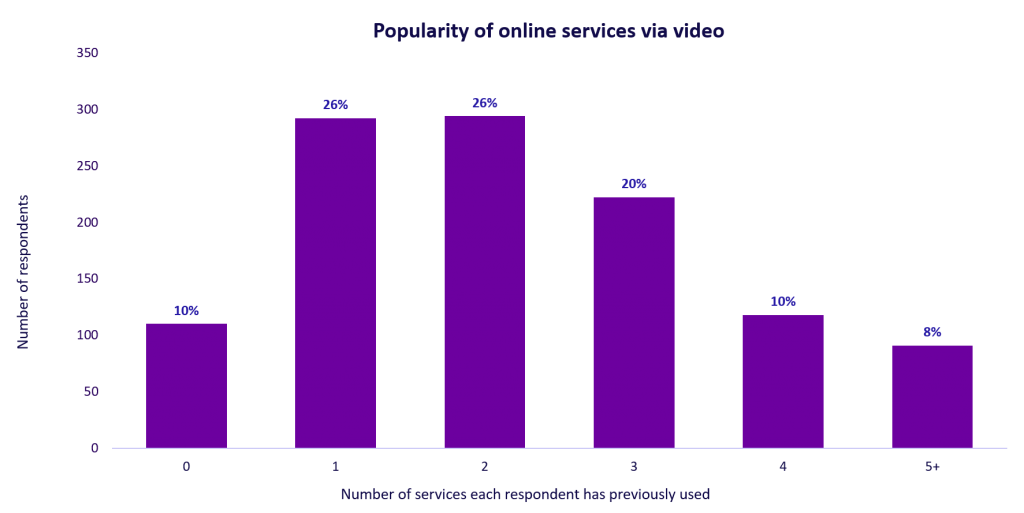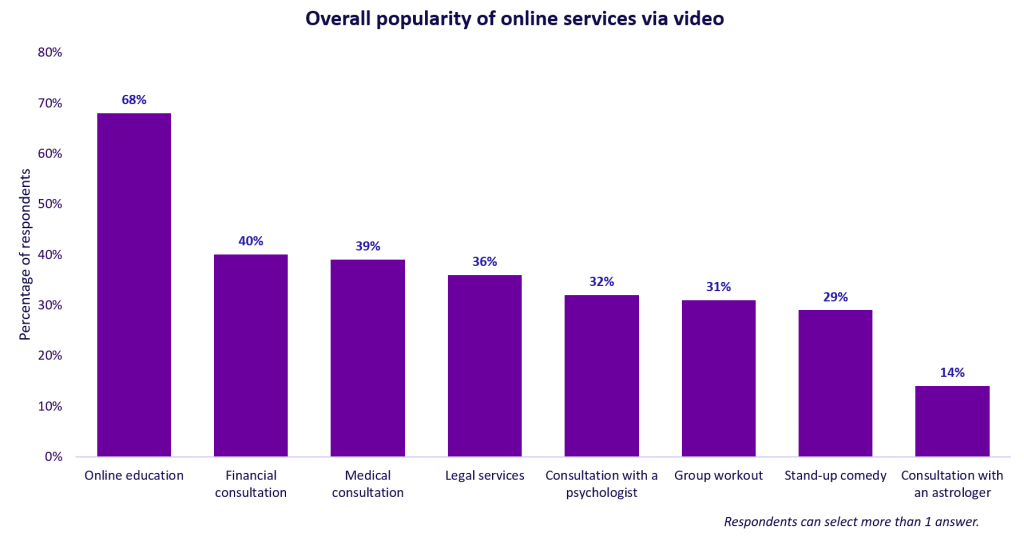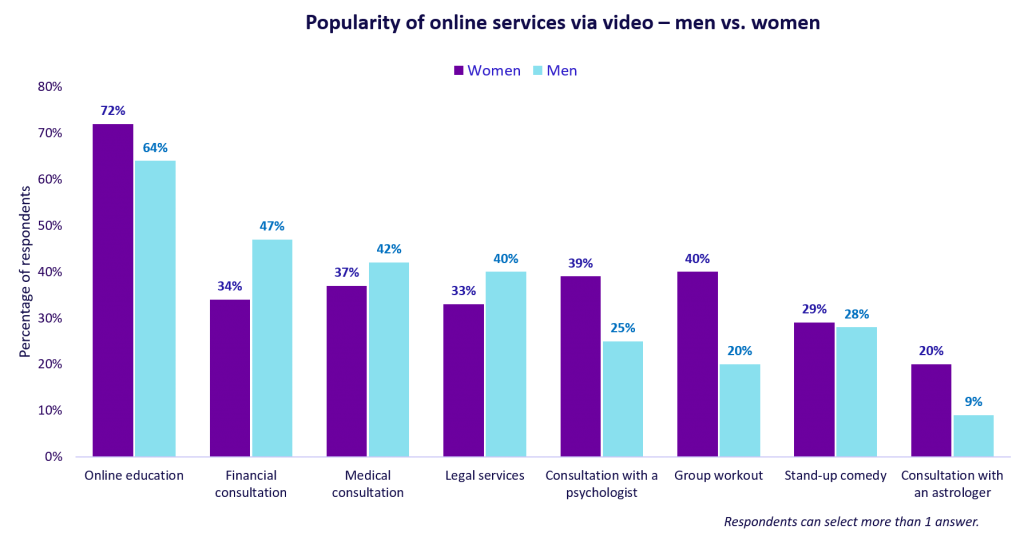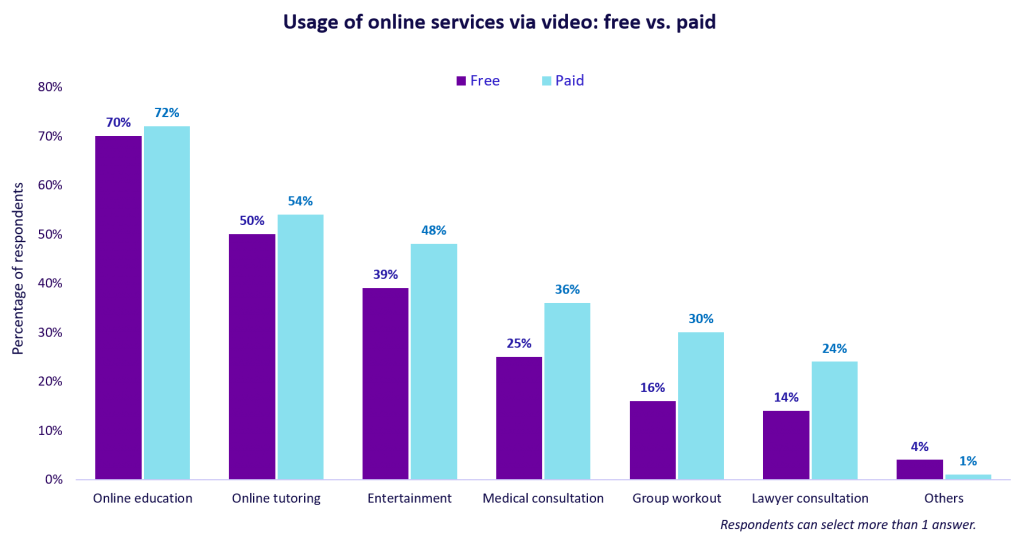So many services are now available via virtual conference call that it’s surprising the statistics about them are so scarce. Therefore the 3veta team decided to research this phenomenon and to find out to what extent online services via video calls have become a part of people’s lives.
The results have shown us some very interesting user attitudes and we are excited to share them with you.
Here’s a list of the findings for quick navigation:
- What online services have we included in our study?
- What are the most used virtual conference call services?
- Who are the users of online services via video calls?
- Paid vs. free online services – is there a difference?
- What other online services are customers excited about?
- Consumer motivation
- What does really matter when offering online services via video calls?
- Price
- Market study methodology
What online services have we included in our study?
Online services can mean a whole lot of things – from online courses to paid video consultations. And although our main focus is on paid services via video calls, part of our survey covers their non-paid cousins of online services that don’t involve a video connection. Consumer attitude towards all non-paid variations can clearly show how inclined people are to be charged for such a service.
What are the most used virtual conference call services?
An overwhelming majority of study participants confirm that online services are used in many areas of everyday life.

64% of people have named at least two different services that they or a member of their household has tried.
Conversely, those who haven’t used any of the listed services or similar, are only 10%. This comes to say that online services are not just a coincidence for the users, but are a consciously sought-after choice.
The most widespread services, used by over 60% of all participants are educational. This includes both online training and courses but also live video classes and lessons (e.g. online school tutoring).
Second place is occupied by entertainment services. 40% of all participants have used some form of organised online entertainment. Examples are live online concerts, stand-up comedy, virtual museum tours, etc.
The third place goes to telemedicine. Online medical consultations are used by almost a third of the cohort.

These results aren’t surprising at all.
Online education services have seen a massive surge over the last decade and the same is valid for telemedicine.
Live online entertainment also got a real push in demand during the COVID-19 pandemic. It’s only natural to expect that these services will increasingly intrigue online services users and will presumably attract more people to provide them.
Who are the users of online services via video calls?
You are probably already guessing that the average online video service user differs depending on the specific service.

For example, educational services are most popular among the under-50s, while online medical consultations are a priority for those over 50.
Group fitness workouts and stand-up comedy are definitely a hit among the younger generations. And if you want to find out how men and women’s interests differ, you will find the biggest difference is in astrology consultations. They seem to be much more enticing for the ladies rather than for the gentlemen.
It is certainly worthwhile to be aware of the demographics of your customers, especially if you want to expand your business. But keep in mind that in the long term people of all ages will require online services (and offer them, too!). The benefits they offer are too tempting to be relevant to only a certain segment of people.
Paid vs. free online services – is there a difference?
A large part of the participants in our survey used a free service.
This, on the one hand, means that the market offers a lot of options for the consumer to try and see the benefits of the online services digitalization.
On the other hand, if we look at the data covering free services, we can make some valid assumptions about the demand for paid ones.
And indeed, the most widely used online services overall are e-learning, entertainment, and medical consultations. But whether they are paid or not, their popularity seems unaffected. What is more, if we focus on paid services, the demand towards these three categories seems to be even bigger!

What other online services are customers excited about?
It is often the case that the market doesn’t match the customer needs. Our survey showed a significant potential for some online services that aren’t so widely offered yet.
When asked what service they would like to use via a video or virtual conference call, many of the respondents insist on financial consultations. What is interesting is that these services are not among the most popular online services in terms of usage, but 40% of the cohort is eager to use them.
Telemedicine and lawyer consultations come immediately after with very similar scores. But when you come to think of it, these three categories are not too dissimilar, which to an extent explains this result.
Consultations with a psychologist or an astrologer are also spurring interest in consumers. 32% and 14% of the respondents, respectively, have indicated they would try them if they had the opportunity.
Consumer motivation
Customers have plenty of benefits from online video services – they save on time and travel costs, and are generally highly convenient.
But which of these benefits matter the most to them?
Our survey showed that there are two main factors that make us prefer a video meeting to a face-to-face one.
With very similar scores, these are the “Service accessibility, regardless of the location”, and “Time saving”.
There is nothing surprising about the fact that we value time savings – we all want to use this most precious resource in the best way possible.
Interestingly, “Service accessibility, regardless of the location” is just as important as “Time saving”.
Presumably, many people have struggled to find the right service, or have been disappointed in the quality. Meaning, if you have been offering services locally, consider that the online market is significantly larger than that. Even if you are uninterested now, it always pays off to invest in improving the way you deliver your service.
What does really matter when offering online services via video calls?
We asked customers to tell us what are the most important factors when using online services via a video call.
And before you read on, remember one thing.
All factors have been scored extremely high – so we are talking about very demanding customers.
If you want to satisfy your customers, this is what you should pay attention to:
- Easy access and registration – 72.5%
- Good quality of the video call – 70.7%
- High service quality – 67.1%
- Price – 62%
Find out more about what really matters to your customers in our dedicated article.
Price
Although price isn’t the most important factor, it always is a dividing one.
Almost half of the respondents are ready to pay the same price for a virtual conference call service as for a face-to-face meeting.
However 46.3% think that video call-based services should be cheaper than face-to-face ones. Their main justification is that providers who choose the online-based model of work will have lower operating costs.
Final pricing, of course, is determined by a number of factors and varies a lot between different services. And although price is important, it is just one of the factors that ultimately make up the consumer’s mind. You can read more about the benefits that justify online services’ price here.
The future of online video services
So it seems that online video services are becoming more and more popular. People are hungry for them and this implies many services providers will be attracted, too.
The growth of virtual conference call will be stimulated mostly by younger consumers (25- to 35-year olds).
Online service users will have higher requirements due to the globalization effect and providers will have to work on several fronts in order to retain their customers. This will certainly prompt an increase in the overall service quality, driving the demand further up.
Education, telemedicine and online entertainment will always top the charts of most popular services. But new offers, such as online financial consultations, will gradually spread in the market, too. In fact, we have already made a list of the most popular online services via video in the coming years. More unconventional service offerings are also expected. Actually, to many people’s surprise, such services are already available.
In short, the coming months and years will be quite interesting. Our team at 3veta will continue to follow the market trends and keep you up-to-date with the latest in the world of online video services. If you are ready to take your online business to the next level, we have the go-to solution for you.
Market study methodology
The study was carried out on 1053 people aged 18 to 64, all active internet users, who filled in a questionnaire online. The sample is entirely based in Bulgaria, a European Union member state. According to a European Commission report, Bulgaria has the slowest rate of adoption of digital solutions in the Union. Therefore, we expect that similar studies carried out on a cohort from a different EU member state (or similarly US, UK, Canada) would only reinforce the overall findings.




